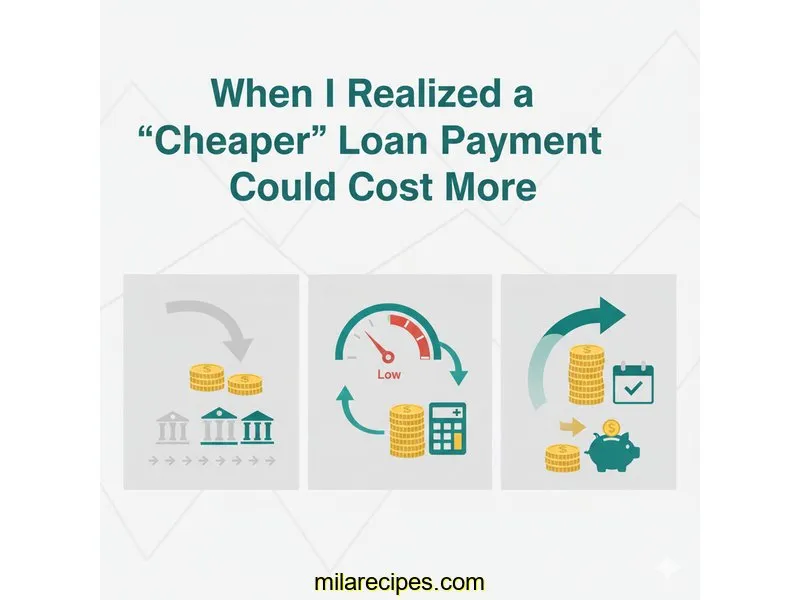
Auto Loan Calculator
Calculate payments over the life of your Loan
Home Blog Privacy Terms About Contact
Calculate payments over the life of your Loan
Home Blog Privacy Terms About ContactPublished on October 13, 2025

My journey into the world of loan calculations started with a simple home project. I wanted to finally build out my home office and needed to figure out the financing. As I started looking into options, I found myself staring at two different scenarios for the same exact loan amount, and a question started nagging at me. It wasn't about which loan to choose, but about the math itself. Why did these numbers behave so differently?
The amount I was looking at was $11,750. One scenario offered a 48-month term, and another offered a 60-month term, both at the same interest rate of 6.3%. The 60-month option had a noticeably lower monthly payment. My initial, gut reaction was simple: "Well, the lower payment is obviously easier on the budget." But I paused. How could paying less each month possibly be anything but better? And if it wasn't better, why wasn't it?
This wasn't about making a financial decision; it was about pure curiosity. The numbers were telling a story, and I realized I didn't know how to read it. I jumped online and found a basic loan calculator, plugging in the numbers. Seeing the results side-by-side just deepened my confusion. I felt like I was missing a key piece of the puzzle. This experience kicked off a weekend project for me: to truly understand the relationship between the loan term, the monthly payment, and the total cost. It was a personal quest to learn the language of these calculations.
I want to be clear from the start: this is my personal story about learning how these calculations work. This is about understanding how calculations work, not financial advice. My goal was simply to satisfy my own curiosity and feel more confident with the math. I just wanted the numbers to make sense.
My initial focus was entirely on that monthly payment figure. The difference felt significant enough to catch my attention immediately. For the $11,750 loan at 6.3%, the calculator showed me:
That's a difference of $49.37 per month. My brain immediately translated that into "nearly $50 in savings every month!" It seemed so straightforward. For the same amount of money borrowed, one path left me with more cash in my pocket each month. My mistake was stopping my thought process right there. I was comparing two numbers in isolation without considering the context that created them.
My frustration began when I looked at another field in the calculator: "Total Interest Paid." This is where the story completely flipped. For the "more expensive" monthly payment of $276.54, the total interest was $1,523.92. For the "cheaper" monthly payment of $227.17, the total interest was $1,880.20. I stared at the screen, completely baffled. How on earth could the option that cost me less each month end up costing me more overall? It felt counterintuitive, like some kind of financial magic trick.
I tried to do the math myself. I multiplied the monthly payments by the number of months. For the 48-month loan, it was $276.54 x 48 = $13,273.92. For the 60-month loan, it was $227.17 x 60 = $13,630.20. It was right there in plain sight, but I hadn't thought to do that simple multiplication. The extra 12 payments on the longer loan more than erased the monthly "savings." I realized I wasn't just paying for the money; I was paying for the time I was using it. That was the missing link in my understanding.
The moment of clarity didn't come from a complicated formula, but from simply slowing down and looking at all the output fields an online calculator provides. I had been so focused on the monthly payment that I'd glossed over the most important information. The breakthrough was realizing that a loan has multiple "costs"—the cost to my monthly budget and the total cost over its entire life.
To really solidify this, I decided to stop just plugging in numbers and start documenting what I was learning. I created a simple table for myself to compare my old way of thinking with my new understanding. It was a powerful visual tool that helped me connect the dots between all the different variables in a loan calculation. Seeing it all laid out made the relationship between time, payments, and interest finally click into place.
The first step in my learning was to look past the monthly number and focus on the total. The calculation is incredibly simple, but I had never bothered to do it: Monthly Payment x Number of Months = Total Payments. Doing this for my two scenarios was the first big reveal. The 60-month loan required me to make 12 extra payments, and that simple fact was the foundation of its higher total cost.
Once I had the Total Payments calculated, understanding the Total Interest was just one more step: Total Payments - Original Loan Amount = Total Interest Paid. This calculation isolated the actual cost of borrowing. For my 60-month scenario, this was $13,630.20 - $11,750 = $1,880.20. Suddenly, this wasn't just a number a calculator spit out; it was a figure I understood and could calculate myself. This made me feel much more in control of understanding the information.
The final piece of the puzzle fell into place when I clicked the "Show Amortization Schedule" button on the online calculator. This was a game-changer. I could see, month by month, how each payment was split between principal and interest. I noticed that for the 60-month loan, a larger portion of each early payment went to interest compared to the 48-month loan. Because the principal was being paid down slower, more interest accrued each month, and this effect compounded over the extra year.
To make sure I really got it, I started playing with the calculator. What if the loan was for $20,000? What if the term was 36 months versus 72 months? Every single time, the pattern held true. The longer the term, the lower the monthly payment, but the significantly higher the total interest paid. Running these different scenarios confirmed that this wasn't a fluke of my original numbers; it was a fundamental principle of how loan math works.
This whole exploration was incredibly empowering. I went from being confused by a couple of numbers to understanding the mechanics behind them. It wasn't about finding the "right" answer, but about learning how to ask the right questions of the numbers. Here are the key lessons about calculation literacy that I took away from this journey:

As I was going through this process, I kept having the same questions pop into my head. Now that I've worked through them, I wanted to share the answers I found for myself.
The loan term is the divisor. In a simplified sense, the calculation takes the total amount to be repaid (principal + total interest) and divides it by the number of months in your term. A higher number of months leads to a smaller result for each month's payment.
Interest is calculated on the remaining balance of the loan. With a longer loan, the principal balance decreases more slowly. This means that for more months, you have a larger outstanding balance that is subject to interest charges, leading to a higher total interest paid over the life of the loan.
From my learning journey, the "Total Interest Paid" is the clearest indicator of the direct cost of borrowing, assuming the loan amount is the same. The "Total Payments" (Principal + Interest) is also excellent because it shows you the complete out-of-pocket amount from start to finish.
This is what the amortization schedule is for. It's a detailed table that breaks down every single payment you'll make. It shows how much of your money goes toward reducing the principal and how much is for interest. Seeing this breakdown, especially for the first year of a loan, was a real eye-opener for me.
My biggest takeaway from this whole exercise is that the most obvious number isn't always the most important one. I started my journey focused entirely on the monthly payment because it felt tangible and immediate. But the real story of the loan's cost was hiding in another field—the total interest paid. Learning to look for that number and understand how it's calculated was the key to my confidence.
I genuinely encourage anyone who feels intimidated by these numbers to open an online loan calculator and just play. Don't worry about making a "decision." Just change the terms, adjust the rates, and watch what happens. See how a small change in one place can cause a big change somewhere else. It's a fantastic way to teach yourself the language of loans without any pressure.
For me, it transformed loan math from a source of confusion into a puzzle I could solve. And that feeling of understanding is incredibly valuable.
This article is about understanding calculations and using tools. For financial decisions, always consult a qualified financial professional.
Disclaimer: This article documents my personal journey learning about loan calculations and how to use financial calculators. This is educational content about understanding math and using tools—not financial advice. Actual loan terms, rates, and costs vary based on individual circumstances, creditworthiness, and lender policies. Calculator results are estimates for educational purposes. Always verify calculations with your lender and consult a qualified financial advisor before making any financial decisions.
